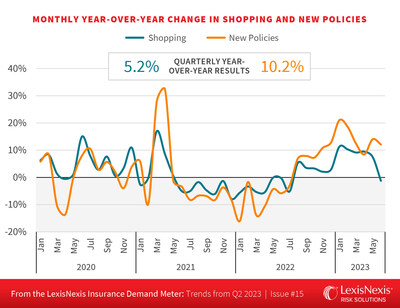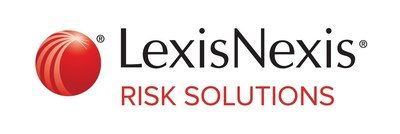LexisNexis Insurance Demand Meter Registers as "Sizzling" for New Policies and "Hot" for U.S. Auto Insurance Shopping
- None.
- None.
Consumers look for – and find – cost savings on auto insurance policies in second quarter
"Profitability is still a challenge for many insurers, driven in large part by a continued rise in claims severity across the market associated with rising costs to repair damaged vehicles," said Adam Pichon, senior vice president of auto insurance and claims at LexisNexis Risk Solutions. "As a result, most carriers are being much more discerning in their underwriting processes and cutting back on marketing spend, but motivated shoppers still sought better cost savings, and switched their policies in record numbers in May and June."
Claims Severities Create a Bumpy Road to Profitability
Increased claims severities have continued to challenge the
"It's a tough situation. Inflationary pressure on repair costs is creating more total losses on top of the added costs to those vehicles that can be repaired – and our data continues to suggest that consumers are shopping near claims events," said Chris Rice, associate vice president of insurance strategic business intelligence, LexisNexis Risk Solutions. "When you combine these macroeconomic factors with claims and injury severities soaring, a lot of insurers have taken a step back to reassess how they will manage risk across their books of business for the foreseeable future."
How are Consumers Responding? Shopping for Cost Savings… and Policy Consolidation
Many insurance carriers have responded conservatively to the current hard market. Lower cost policies may be difficult to find, but savvy shoppers are still finding them, leading to very high new policy growth numbers in recent quarters. But new policy growth is only part of the consumer story.
While new policy volumes remain on the rise,
A Look Ahead
Pichon also advises to keep a close eye on the property insurance market, which may be following the auto insurance market's lead in raising rates.
"We indicated in previous editions of the Demand Meter that there would be an opening for opportunistic shoppers to find cost savings when shopping for auto insurance this year, and that was certainly the case," said Pichon. "But how long can certain carriers that have been slower to take rate afford not to do so at the scale of some of their competitors? Now, we are seeing some similar rate-taking activity on the property insurance side of the equation, which could be another key factor that drives shopping over the remainder of the year."
"A lot of carriers are gearing up for the next round of rate increases," continued Pichon. "How consumers respond with respect to shopping in Q3, including how many more might exit the market, should give us a pretty good look at what 2024 may hold."
Download the latest Insurance Demand Meter.
About the LexisNexis Insurance Demand Meter
The LexisNexis Insurance Demand Meter is a quarterly analysis of shopping volume and frequency, new business volume and related data points. LexisNexis Risk Solutions offers this unique market-wide perspective of consumer shopping and switching behavior based on its analysis of billions of consumer shopping transactions since 2009, representing nearly
About LexisNexis Risk Solutions
LexisNexis® Risk Solutions harnesses the power of data and advanced analytics to provide insights that help businesses and governmental entities reduce risk and improve decisions to benefit people around the globe. We provide data and technology solutions for a wide range of industries including insurance, financial services, healthcare and government. Headquartered in metro Atlanta,
Through leading data and analytics solutions, LexisNexis Risk Solutions helps leading insurance companies automate and improve critical business processes, reduce expenses, combat fraud and gain pivotal insights to differentiate and deliver higher levels of customer experience across multiple lines of business. For more information, visit risk.lexisnexis.com/insurance.
Media Contacts:
Chas Strong
LexisNexis Risk Solutions
Phone: +1.706.714.7083
Charles.Strong@lexisnexisrisk.com
Mike Brewer
Brodeur Partners for LexisNexis Risk Solutions
Phone: +1.617.587.2865
mbrewer@brodeur.com
i LexisNexis Risk Solutions Internal Data | |
ii LexisNexis Risk Solutions Internal Data | |
![]() View original content to download multimedia:https://www.prnewswire.com/news-releases/lexisnexis-insurance-demand-meter-registers-as-sizzling-for-new-policies-and-hot-for-us-auto-insurance-shopping-301902960.html
View original content to download multimedia:https://www.prnewswire.com/news-releases/lexisnexis-insurance-demand-meter-registers-as-sizzling-for-new-policies-and-hot-for-us-auto-insurance-shopping-301902960.html
SOURCE LexisNexis Risk Solutions
FAQ
What is the growth rate of U.S. auto insurance shopping in Q2 2023?
What was the rate of new policy growth in Q2 2023?
What is causing challenges in the U.S. auto insurance market?
What are insurers doing in response to the challenges in the market?
Are consumers still switching policies to find cost savings?
What is contributing to slower in-force growth?
Will the property insurance market also raise rates?








